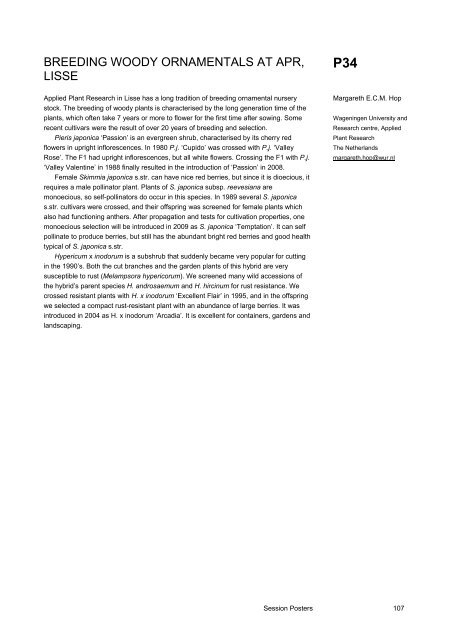XXIIIrd International Eucarpia symposium, Section Ornamentals ...
XXIIIrd International Eucarpia symposium, Section Ornamentals ...
XXIIIrd International Eucarpia symposium, Section Ornamentals ...
You also want an ePaper? Increase the reach of your titles
YUMPU automatically turns print PDFs into web optimized ePapers that Google loves.
BREEDING WOODY ORNAMENTALS AT APR,<br />
LISSE<br />
Applied Plant Research in Lisse has a long tradition of breeding ornamental nursery<br />
stock. The breeding of woody plants is characterised by the long generation time of the<br />
plants, which often take 7 years or more to flower for the first time after sowing. Some<br />
recent cultivars were the result of over 20 years of breeding and selection.<br />
Pieris japonica ‘Passion’ is an evergreen shrub, characterised by its cherry red<br />
flowers in upright inflorescences. In 1980 P.j. ‘Cupido’ was crossed with P.j. ‘Valley<br />
Rose’. The F1 had upright inflorescences, but all white flowers. Crossing the F1 with P.j.<br />
‘Valley Valentine’ in 1988 finally resulted in the introduction of ‘Passion’ in 2008.<br />
Female Skimmia japonica s.str. can have nice red berries, but since it is dioecious, it<br />
requires a male pollinator plant. Plants of S. japonica subsp. reevesiana are<br />
monoecious, so self-pollinators do occur in this species. In 1989 several S. japonica<br />
s.str. cultivars were crossed, and their offspring was screened for female plants which<br />
also had functioning anthers. After propagation and tests for cultivation properties, one<br />
monoecious selection will be introduced in 2009 as S. japonica ‘Temptation’. It can self<br />
pollinate to produce berries, but still has the abundant bright red berries and good health<br />
typical of S. japonica s.str.<br />
Hypericum x inodorum is a subshrub that suddenly became very popular for cutting<br />
in the 1990’s. Both the cut branches and the garden plants of this hybrid are very<br />
susceptible to rust (Melampsora hypericorum). We screened many wild accessions of<br />
the hybrid’s parent species H. androsaemum and H. hircinum for rust resistance. We<br />
crossed resistant plants with H. x inodorum ‘Excellent Flair’ in 1995, and in the offspring<br />
we selected a compact rust-resistant plant with an abundance of large berries. It was<br />
introduced in 2004 as H. x inodorum ‘Arcadia’. It is excellent for containers, gardens and<br />
landscaping.<br />
P34<br />
Margareth E.C.M. Hop<br />
Wageningen University and<br />
Research centre, Applied<br />
Plant Research<br />
The Netherlands<br />
margareth.hop@wur.nl<br />
Session Posters 107














